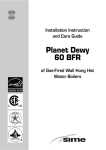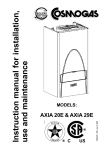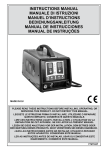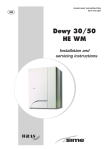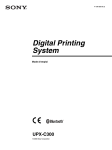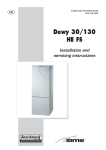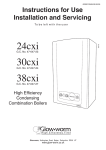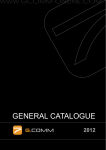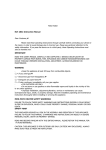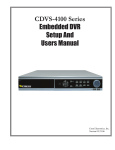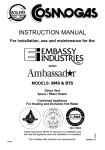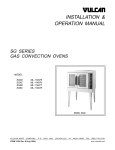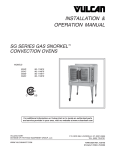Download Celsior 35 BF Operating instructions
Transcript
CLIOM-2 “Combi” Gas-Fired Boiler/Water Heater Model 35 BF Installation and Operating Instructions 315 Oser Avenue • Hauppauge, NY 11788 Tel: (631) 694-1800 • Fax: (631) 694-1832 www.embassyind.com Fonderie Sime S.p.A. Via Garbo, 27 – 37045 LEGNAGO (VR) declares that: a) The materials used in the interior of the boiler are suitable for the use of drinking water. b) No dangerous toxic substances were used to manufacture the boiler and its components, which could enter the drinking water. c) There is no contact zone between drinking water and the water used for the heating system. déclare que: a) Les matériels utilisés à l’intérieur de la chaudière sont idoines pour l’utilisation de l’eau potable. b) Dans la fabrication de la chaudière et de ses composants aucune substance toxique dangereuse n’a été utilisée qui pourrait s’infiltrer dans l’eau potable. c) Il n’existe aucune zone de contact entre l’eau potable et l’eau du circuit de chauffage. Date: 02/03/2009 CLAUDIO MEZZALIRA Fonderie SIME Spa Technical Manager Installation Instruction and User and Care Guide ENG TABLE OF CONTENTS WARNING: If the information in this manual is not followed exactly, a fire of explosion may result causing property damage, personal injury or loss of life. • Do not store or use gasoline or other flammable liquids or gases in the vicinity of this or any other appliance. • WHAT TO DO IF YOU SMELL GAS • Do not try to light any appliances. • Do not touch any electrical switches, do not use any phone in your building. • Immediately call your gas supplier from a neighbour’s phone. Follow the gas supplier’s instructions. • If you cannot reach the gas supplier, call the fire department. • Installations and service must be performed by a qualified installer, service agency or the gas supplier. Warning: Do not use this boiler if any part has been under water. Immediately call a qualified service technician to inspect the boiler and to replace any part of the control system and any gas control which has been under water. Warning: Should overheating occur, or the gas supply fail to shut off, shut off the gas supply external to the appliance. Do not switch off the electrical supply to the pump. 1 DESCRIPTION OF THE BOILER 4 1.1 1.2 INTRODUCTION DIMENSIONS 4 4 2 INSTALLATION 7 2.1 2.2 2.3 2.4 2.5 2.6 2.7 2.8 2.9 VENTILATION OF BOILER ROOM INSTALLATION PLATE CONNECTING UP SYSTEM SYSTEM FILLING FLUES/CHIMNEYS INSTALLATION COAXIAL DUCT INSTALLATION SEPARATE PIPES POSITIONING OF OUTLET TERMINALS ELECTRICAL CONNECTION 7 7 7 8 9 9 9 11 13 3 CHARACTERISTICS 22 3.1 3.2 3.3 3.4 3.5 3.6 3.7 ELECTRONIC BOARD TEMPERATURE SENSOR ELECTRONIC IGNITION SMOKE PRESSURE SWITCH FLOW SWITCH WATER HEAD AVAILABLE TO SYSTEM ELECTRICAL WIRING OF ZONE HEATING SYSTEMS 22 22 22 23 23 23 4 USE AND MAINTENANCE 24 4.1 4.2 4.3 4.4 4.5 4.6 4.7 4.8 D. H. W. TEMPERATURE ADJUSTMENT ADJUSTAMENT OF D. H. W. FLOW RATE GAS VALVE GAS CONVERSION DISMANTLING THE CASING CLEANING AND MAINTENANCE FAULT FINDING LOCATION MAIN SHUTOFF VALVE 24 25 25 25 26 26 27 28 5 EXPLODED VIEWS 29 24 3 1 1.1 INTRODUCTION Celsior boilers are gas-fired thermal appliances for central heating and domestic hot water production, designed and manufactured to satisfy the needs of multiple dwelling and modern boiler room requirements. They comply with ANSI Z21. 13 and CSA 4.9 GAS FIRED LOW PRESSURE STEAM AND HOT WATER BOILERS. These appliances can be fired by both natural gas and Liquid Propane Gas. This booklet provides the instructions for the Celsior with eletronic ignition, modulation, and direct sealed forced-draught. The instructions given in this manual are provided to ensure proper installation and perfect operation of the appliance. 1. Make sure that there are no liquids or inflammable materials in the immediate vicinity of the boiler. 2. Make sure that the electrical connections have been made correctly and that the earth wire is connected to a good earthing system. 3. Open the gas cock and check the soundness of the connections, including that of the burner. 4. Make sure that the boiler is set for operation for the type of gas supplied. perly installed. 6. Make sure that any shuotff valves are open. 7. Make sure that the system is charged with water and is thoroughly vented. 8. Check that the circulating pump is not locked. 9. Purge the system, bleeding off the air present in the gas pipe according to procedures outlined in the local codes or those having jurisdiction. 10. The installer must provide the user with instruction in operation of the boiler and safety devices and hand over the instruction booklet to the user. 5. Check that the flue pipe ensuring the outlet of products of the combustion is unobstructed and has been pro- DIMENSIONS: mm (in) Dimension R C.H. return M C.H. supply G Gas connection E D.H.W. inlet U D.H.W. outlet 125 (4.92) 107 (4.21) 60 (2.36) 1.2 IMPORTANT When carrying out commissioning of the boiler, you are highly recommended to perform the following checks: U E Units C C MNPT C C Type 35 BF 3/4” (19 mm) 3/4” (19 mm) 3/4” (19 mm) 1/2” (13 mm) 1/2” (13 mm) G M R 205 (8.07) 55 (2.17) 55 (2.17) 677 (26.65) 700 (27.56) ø 60/100 110 (4.33) 41(1.61) 165 (6.50) 22 (0.87) ENG DESCRIPTION OF THE BOILER G R 450 (17.72) 125 (4.92) 60 (2.36) 335 (13.19) = M E 70 70 70 70 (2.75) U = Figure 1 4 Model 35 BF Units Natural gas Propane kW 39.2 35.2 But/h 133,800 120,000 kW 23.2 21.3 But/h 79,200 72,700 kW 32.7 31.1 But/h 111,700 106,300 kW 19.6 17.8 But/h 66,900 60,700 l 8.0 8.0 USgal 2.1 2.1 Electric Power consumption W 165 165 Maximum C.H. pressure bar 3 3 psi 43.5 43.5 °C 85 85 F 185 185 l 8 8 USgal 2.1 2.1 bar 1 1 psi 14.5 14.5 °C 40-80 40-80 F 104-176 104-176 °C 30-60 30-60 F 86-140 86-140 l/min 15.5 14.7 USgal/min 4.09 3.89 l/min 2.4 2.4 USgal/min 0.63 0.63 bar 0.50 0.50 psi 7.3 7.3 bar 8.6 8.6 psi 125 125 III III kg 40 40 lb 88.2 88.2 n° 15 15 Orifice ø mm 1.30 0.85 Maximum manifold gas pressure mbar 13.7 24.9 “W.C. 5.5 10.0 mbar 5.0 8.7 “W.C. 2.0 3.5 mbar 16.2 30 “W.C. 6.5 12.0 Maximum input Minimum input Maximum output Minimum output Water content Maximum C.H. temperature Expasion vessel Water content Expasion vessel Pre-charged C.H. setting range D.H.Wsetting range Continuous D.H.W. flow rate ∆t 30°C Minimum D.H.W. flow rate Minimum D.H.W. pressure Maximum D.H.W. pressure Vent Category Weight Quantity of burners Minimum manifold gas pressure Minimum gas supply pressure CLEARANCES FROM COMBUSTIBLE MATERIALS: ENG Bottom: 0 mm (0 in.) Sides: 0 mm (0 in.) Rear: 0 mm (0 in.) Front: 0 mm (0 in.) Top: 0 mm (0 in.) Flue (superate vent): 150 mm (6 in.) Flue (co-axial vent): 50 mm (2 in.) CLEARANCES FROM SERVICE AND PROPER OPERATION: Bottom: 150 mm (6 in.) Sides: 150 mm (6 in.) Rear: 150 mm (6 in.) Front: 600 mm (24 in.) Top: 150 mm (6 in.) MINIMUM CLEARANCES FROM ELECTRIC METERS, GAS METERS, REGULATORS AND RELIEF EQUIPMENT : US: 4 feet (1.22 m) CND: 6 feet (1.83 m) 5 ENG KEY 1 Fan 2 Main exchanger 3 Combustion chamber 4 Gas valve 5 D.H.W. plate exchanger 6 Divertor valve 7 C.H. sensor (SM) 8 100°C safety stat 10 Pump with automatic air vent 11 Expansion vessel 12 Safety valve 13 Boiler discharge 14 Water flow switch 15 Tridicator 16 Automatic by-pass 17 D.H.W. filter 18 C.H. return cock 19 C.H. flow cock 20 D.H.W. cock 21 Gas cock 22 Aqua Guard Filter System Figure 2 6 5 7 8 4 9 10 3 KEY 1 Control panel 3 Combustion chamber 4 Fan 5 Combustion analysis intakes 6 Negative pressure intake 7 Positive pressure intake 8 Smoke pressure switch 9 C.H. sensor (SM) 10 Main exchanger 11 100°C safety stat 12 Gas valve 13 Flow water switch 14 Divertor valve 15 Aqua Guard Filter System 19 11 13 12 14 1 Figure 3 6 2 INSTALLATION The installation must conform to the requirements of the Authority having jurisdiction or, in the absence of such requirement, to the National Fuel Gas Code, ANSI Z223.1/NFPA 54 and, or CAN/CGAB149 Installation Code. Where required by the Authority having jurisdiction, the installation must conform to the Standard for Controls and Safety Devices for Automatically Fired Boilers, ANSI/ASME CSD-1. All boilers must be installed with a proper pressure relief valve. Pressure relief valves must be installed to confirm to ANSI/ASME Boiler and Pressure Vessel Code, Section IV, or CSA B51, as applicable. If the boiler is installed above the radiation level, or as required by the Authority having jurisdiction, the installer must provide a low water cut-off device at a time of installation. The boiler must be installed in a fixed location and only by a qualified installer, service agency or the gas supplier and is familiar with the requirement that are contained in this manual. Furthermore, the installation must be in accordance with current standars and regulations. The boiler must not be installed on carpeting. The boiler when used in connection with a refrigeration system, must be installed so the chilled medium is piped in parallel with the boiler with appropriate valves to prevent the chilled medium from entering the boiler. The boiler piping system of a hot water boiler connected to heating coils located in air handling units where they may be exposed to refrigerated air circulation must be equipped with flow control valves or other automatic means to prevent gravity circulation of the boiler water during the cooling cycle. Service instructions and recommended frequency guidelines periodic examination of venting systems every six months. Venting systems, the vent-air intake system, screens in the vent terminal should be checked and cleaned every six months. Low water cutoff should be checked and cleaned every six months. Remove small cover retaining screw and remove the cover. When the pump is running and water is flowing around the boiler , the actuator lifts off the micro switch. Check that the operation of the actuator ; Ensure that it is free and that it lifts and returns. If necessary lubricate the pivot point of the actuator. Flue gas passageways should be checked and cleaned every six months. The burner should be checked and cleaned every six months. Inspect the burner and if necessary clean using a soft brush and a vacuum cleaner, taking care not to damage the front insulation. Check the ignition /ionisation electrode, check the ignition spark gap (3.5 mm +/- 0.5 mm) (0.138 in. +/- 0.02 in.). Before reassembly inspect all seals and replace as required. Furthermore, the installation must be in accordance with current standards and regulations. 2.1 53, Air for Combustion and Ventilation, of the National Flue Gas Code, ANSI Z 223,1/NFPA 54, or section 7,2, 7.3, or 7.4, of CAN/CGA B 149, Installation Codes, or local codes having jurisdiction. Where an exhaust fan or any other air consuming appliance is installed in the same space as the boiler, sufficient air openings must be available to provide fresh air when all appliance are operating simultaneously. It is essential that in rooms where the boiler are installed at least as much air can arrive as required by normal combustion of the gas consumed by the various appliances. Consequently, it is necessary to make openings in the walls for the air inlet into the rooms. These openings must meet the following requirements: 1. Have a total free section of a least 2225 mm2 every kW (1 in2 for every 1000 Btu/ hr) of heat input, with a minimum of 100 cm2 (15.5 in2); 2. They must by located not more than 18 in or less than 6 in above the floor level, not prone to obstruction and protected by a grid which does not reduce the effective section required for the passage of air; 3. Where requide by jursdiction or when required for additional opening must be provided at the highest elevation practical. 2.2.2 2.2 INSTALLATION PLATE The installation plate code 6246958 is supplied with the boiler. The optional installation plate code 8075416 is supplied with an instruction sheet for the fixing. 2.2.1 Isolating valves kit To fit the isolating valves, supplied with the boiler, use figure 4 for assembly. ENG The follow is available to facilitate water and gas connection of the boiler with the heating system: for assembly of the unions to see fig. 1. 2.3 CONNECTING UP SYSTEM To protect the heat system from damaging corrosion, flakes or deposits, before installation it is extremely important to clean the system using suitable products such as, descaler or slug removing solution. For long-term protection against corrosion and deposits, the use of inhibitors is required for new installations and after cleaning the system. It is important to check the concentration of the inhibitor after each system modification and during maintenance following the manufacturer’s instructions (specific tests are available at your dealer). The safety valve drain must be connected to a collection funnel to collect any discharge during interventions. If the heating system is on a higher floor than the boiler, install the on/off taps supplied in kit on the heating system delivery/return pipes. WARNING: Failure to clean the heat system or add an adequate inhibitor invalidates the device’s warranty. 2.3.1 With a hermetically sealed combustion chamber and air supply circuit from outdoors, may be installed in any room in the home. Keep boiler area clear and free from combustible materials, gasoline and other flammable vapors and liquids. System connection unions Gas Requirements Read the date plate to be sure the water heater is made for the type of gas being used. An adhesive data plate is stuck inside the front panel, it contains all the technical data identifying the boiler and the type of gas for which the boiler is arranged. If the information does not agree with the type of gas available, do not install or operate the water heater. Call your dealer. The gas piping must be installed according to all local and state codes, or in absence of local and state codes, with the latest “Natural gas and propane installation code”, CAN/ CSA-B 149.1 or “National Flue Gas Code”, ANSI Z223.1 (NFPA 54). Consult the “Natural gas and propane installation code” or “National Flue Gas Code” for the recommended gas R M G E U C.H. return C.H. supply Gas connection D.H.W. inlet D.H.W. outlet VENTILATION OF BOILER ROOM When using air from the boiler room, an adequate air supply shall by provided for combustion of this boiler. An insufficient supply can result in poor combustion and possible sooting of the burner, combustion chamber or flue passageway. The boilers installed using inside air supply must provide provisions for Combustion Air and Ventilation Air in accordance with section Figure 4 7 ENG pipe size of other materials. The sections of the piping making up the system must be such as to guarantee a supply of gas sufficient to cover the maximum demand, limiting pressure loss between the gas meter and any apparatus being used to not greater than: 1. 1.2 mbar (0.5”W.C.) for supply pressures under 17 mbar (7”W.C.); 7 6 8 2. 2.5 mbar (1.0”W.C.) for supply pressures from 17 mbar (7”W.C.) to 35 mbar (14”W.C.). 2.3.2 Filter on the gas pipe The gas valve is supplied by the factory with an inlet filter, which, however, is not adequate to entrap all the impurities in the gas or in gas main pipes. To prevent malfunctioning of the valve, or in certain cases even to cut out the safety device with which the valve is equipped, install an adequate filter on the gas pipe. In any case, a sediment trap must be installed upstream of the gas controls. 2.4 SYSTEM FILLING Filling of the boiler and the system is done by installing a pressure reducing valve. The charge 8 5 1 3 2 KEY 1 D.H.W. inlet/outlet manifold 3 D.H.W. filter 4 By-pass 5 Water rate adjuster 4 9 6 7 8 9 D.H.W. exchanger Microswitches Water flow switch Boiler discharge Figure 5 x 2 4 y 3 min 4.27 - max 16.4 ft min 1,3 m - max 5 m min 1,3 m - max 5 m Gas connestions must be made in accordance with current standards and regulations. When dimensioning gas pipes from the meter to the boiler, both capacity volume (consumption) in m3/hr (ft3/hr) and gas density must be taken into account. The boiler and the boilers gas connection must be leak tested before it is put in to operation. The boiler and its individual shut-off valve must be disconnected from the gas supply piping system during pressure testing of the system at pressures in excess of 1/2 psi (3.5 kPa). The boiler must be isolated from the gas supply piping system by closing its individual manual shut off valve during any pressure testing of the supply piping system at test pressures equal to or less than 1/2 psi (3.5 kPa). The boiler shall be installed such that the gas ignition system components are protected from water (dripping, spraying, rain etc.) during boiler operation or service (circulators or control replacement etc.). The boiler and its gas connection must be leak tested before placing the the boiler is put into operation. Use a chloride-free soap and water solution (bubbles forming indicate a leak) or other approved method. After placing the boiler in operation, the ignition system safety shutoff device must be tested. To testing the system: - Close the gas valve (gas cock) - feed to boiler - initiate a call for heat (see user instructions) - verify red led “Ignition lock-out” light is on, after ignition boiler. - reset boiler by rotating the function knob to chimney sweep and stay at least one second, and after back to “winter” or “summer” position. - finally open the gas cock. 7 6 2 3 8 C42 C32 x + y = max 3,5 m "25" x + y = max 3,0 m "30-35" IMPORTANT: – Each additional 90° curve (code 8095801) installed reduces the available length by 0.90 metres (3 ft). – Each additional 45° curve installed reduces the available length by 0.45 metres (1.5 ft). – It is advisable to assemble the condensation collector (8) on vertical segments exceeding 2.5 metres (8.2 ft) in length and to limit maximum length to 4 metres (13.1 ft). 13.1 ft maxmaximum 3,5 m "25" max m max 3,0 m 4.0 "30-35" C12 2 1 KEY 1 Coaxial flue kit L. 810 mm (32 inch) code 8084811 2 a Extension L. 1000 mm (39.4 inch) code 8096103 2 b Extension L. 500 mm (19.7 inch) code 8096102 3 Vertical extension L. 200 mm (7.9 inch) code 8086908 6 Articulated tile code 8091300 7 Roof outlet terminal L. 1284 mm (50.6 inch) code 8091200 8 Vertical condensation collector L. 200 mm (7.9 inch) cód. 8092803 Figure 6 pressure, with the system cold, must be between 1 and 1.2 bar (14.5 and 17.4 psi). During system filling you are recommended to keep the main switch turned OFF. Filling must be done slowly so as to allow any air bubbles to be bled off through the air valves. Should the pressure have risen well above the limit expected, discharge the over pressure by opening the pressurerelief valve. Bleed pump by loosen plug at back of motor. Once air is removed re-tighten plug. It may be necessary to free the pump motor before filling the system. This is done by removing the pump plug and turning the pump shaft loose. Do not forget to re-tighten pump plug before filling system. See typical piping in the figure below. 2.4.1 Emptying the system (fig. 5) 2.5.1 Passing flue pipes through an existing chimney When renovating or passing flue pipes through an existing chimney, use only flues which are declared suitable for the purpose by the manufacturer, following the instructions for installation and use provided by the manufacturer. 2.6 INSTALLATION COAXIAL PIPE (fig. 6) The air inlet-smoke outlet assembly ø 60/100 is supplied in a kit code 8084811 complete with mounting instructions. With the curve supplied in the kit the maximum horizontal length of the flue must not exceed 4 m (13 ft). The diagrams in fig. 6 illustrate a number of examples of different coaxial outlets. 2.6.1 Coaxial flue diaphragm (fig. 6/a) Use the drain tap to empty the system (9). Turn off the boiler before doing this. 2.5 FLUES/CHIMNEYS The flue or chimney used to release the products of combustion into the atmosphere must comply with current standards and regulations. Horizontal vent lengths must be supported every I meter (39 in) or less to prevent sagging. The boiler is supplied as standard with a ø 86 diaphragm. With outlet type C12, install diaphragm ø 84 mm (3.3 inch) only if the coaxial flue is less than 1 metres (3.3 ft) long. For C32 discharge options, it is necessary to order the optional diaphragm separately and use it in accordance with the instructions provided in figure 6/a. 2.7 INSTALLATION SEPARATE PIPES ENG The smoke pipe must be certified ø 3” category III venting. When installing the pipes, follow closely the requirements of the current standards and regulations, as well as the following practical pointers: 1. With direct intake from outside, when the pipe is longer than 1 m (3.3 ft), you are recommended to insulate the piping so as to prevent formation of dew on the outside of the piping during particularly hard periods of the year. 2. With the outlet pipe outside the building or in cold indoor environments, insulation is necessary to prevent burner failure during trial for ignition. In such cases, provide for a condensate-collector system on the piping. 3. If a segment of the flue passes through a flammable wall, this segment must be insulated with a glass wool pipe insulator 30 mm (1 in) thick, with a density of 50 kg/ m3 (3lb/ft3) or follow vent manufacturers instructions for clearances to combustibles. TYPICAL PIPING HOT WATER SUPPLY COLD WATER SUPPLY COLD WATER SUPPLY BOILER LOOP LOW TEMPERATURE LOOP HIGH TEMPERATURE LOOP 9 ENG 4. The distance between the intake air and the smoke pipe must be within 300 mm (12 in) - (see fig. below). 5. The head loss of the smoke pipe cannot exceed by more than 4.8 mm (0.19 in) of the intake head loss. 6. Outlet terminal must be flush with the wall and the inlet terminal must protrude at least 50 mm (2 in) from the outstide wall (see fig. below). The maximum overall length of the intake and exhaust ducts depends on the head losses of the single fittings installed and must not be greater than 12 mm H2O (0.472 “W.C.). (ATTENTION! The total length of linear exhaust sections should not exceed 8 m (26 ft) as compared to the total length of linear suction sections). For head losses in the fittings, refer to Table 1 and example fig. 7. Slanted view With outlet type C12, install diaphragm ø 84 mm/3.3 inch only if the coaxial flue is less than 1 metres (3.3 feet) long. With outlet type C32, use the following diaphragms, depending on flue length and without any additional curves: Installations with vertical Installations with vertical condensation extension L. 200 mm/7.9 inch code 8086908 collector code 8092803 Diaphragm Diaphragm Without Diaphragm None ø 86/3.4” ø 87.5/3.44” diaphragm ø 87.5/3.44” diaphragm (cod. 6028623) (cod. 6028624) (cod. 6028624) L min = 1,3 m L min = 2,5 m L min = 4 m L min = 2,5 m 4.27 ft 8.2 ft 13.1 ft 8.2 ft L max = 2,5 m 8.2 ft L max = 4 m 13.1 ft L max = 5 m 16.4 ft L max = 2,5 m 8.2 ft L max = 4 m 13.1 ft Figure 6/a TABLE 1 Vent Accessories ø 3” 45° curve MF 90° curve MF Extension L. 1000 mm/39.4 inch (horizontal) Extension L. 1000 mm/39.4 inch (vertical) Terminal 1 (Termination box : 2SVSRTF) Terminal 2 (Termination hood : 2SVSHTX) Intake terminal Manifold Roof outlet terminal L.1390 Condensation collection T Frontal view Load loss in mm H2O (“W.C.H2O) Intake 0.6 (0.024) 0.65 (0.026) 0.3 (0.012) 0.3 (0.012) ------------0.2 (0.008) 0.3 (0.012) ------------- Outlet 0.3 (0.012) 0.5 (0.020) 0.13 (0.005) 0.06 (0.002) 0.8 (0.0315) 0.6 (0.0236) ------------------1.1 (0.043) Roof outlet/Intakes ------------------------------------------------0.6 (0.024) ------- Example of allowable installation calculation in that the sum of the head losses of the single fittings is less than 7.0 mm H2O (0.276 “W.C.H2O): Intake Outlet 23ft horizontal pipe ø 3” mm x 0.30 2,1 --–-23ft horizontal pipe ø 3” x 0.13 --–-0,91 n° 2 90° elbows ø 3” x 0.65 1,3 --–-n° 2 elbows 90° ø 3” x 0.50 --–-1,0 n° 1 terminal ø 3” 0,2 2,0 Total head loss 3,6 + 3,91 = 7,51 mmH2O (0.296 “W.C.H2O) With this total head loss, remove the segments from n. 1 to n. 9 from diaphragm in the intake pipe. Figure 7 10 Separate flue kit (fig. 8) 1 6 110 3 165 2 100 (3,94”) 100 (4.33”) ø 80 (ø 3“) 205 (8.07”) K 92 (6.5”) 165 4 (3.62”) The separate flue kit code 8089909 is supplied with an intake diaphragm which must be used as shown in fig. 8/a, depending on the maximum load loss permitted in both flues. To use the air intake in this type of outlet you must perform the following operations (fig. 9): 1 Remove the base of the air intake, using a tool to cut it off (a); 2 Overturn the air intake (b) and replace the seal (5) with the seal supplied in the kit code 8089909; 3 Insert the intake diaphragm supplied in the kit code 8089909, pushing it in until it is in contact with the bottom bead. You can now insert the extension or curve in its housing to complete the intake. You need not use any seal or sealant, as gasket provided is sufficient. ø 80 (ø 3“) ENG (6,5”) 2.7.1 2.7.2 Outlet systems The diagrams in fig. 9/a illustrate a number of examples of different types of separate outlets. 2.8 POSITIONING OF OUTLET TERMINALS (fig. 11) KEY 1 (ø 125/95 mm - ø 4.92/3.74 inch) sponge seal 2 Fixing screw 3 Flue outlet flange 4 Inlet air diaphragm 6 Manifold with intakes The outlet terminal must be flush with the wall and the inlet terminal must protrude 50 mm (2 in) from the outstide wall at least. N° segments to remove n° 1 and 2 from n° 1 to 3 from n° 1 to 4 from n° 1 to 5 from n° 1 to 6 from n° 1 to 7 from n° 1 to 8 from n° 1 to 9 from n° 1 to 10 without diaphram Figure 8 Load loss (mm H2O) 0 - 1.0 1.0 - 2.0 2.0 - 3.0 3.0 - 4.0 4.0 - 5.0 5.0 - 6.0 6.0 - 7.0 7.0 - 8.0 8.0 - 10.0 10.0 - 12.0 (“W.C.H2O) 0 - 0.039 0.039 - 0.079 0.079 - 0.12 0.12 - 0.16 0.16 - 0.20 0.20 - 0.24 0.24 - 0.28 0.28 - 0.31 0.31 - 0.39 0.39 - 0.47 Figure 8/a a IMPORTANT: The three housings on the diaphragm permit assembly of the air intake in one position only. b 5 Figure 9 11 ENG 11 10 9 11 3 3 2 1 10 7 3 C42 8 2 1 3 3 3 12 1 6 3 2 8 C52 B52 3 6 3 3 1 5 4 KEY 1 2a 2b 3a 3b 3c 4 5 6 7 8 9 10 11 12 Separate flue kit code 8089909 90° elbow MF Isolated 90° elbows MF Extension L. 1000 mm (39.4 inch) Insulated extension L. 1000 mm (39.4 inch) Extension L. 500 mm (19.7 inch) Outlet terminal Int.-est. ring kit Intake terminal 45° elbow MF Condensation outlet L. 135 mm (5.31 inch) Doubler fitting Tile with articulated joint Roof outlet terminal L. 1390 mm (54.7 inch) Tee condensation outlet max 0,5 m 2 C82 B22 0,3 m (12inches) max 0,5 m 3 1 C12 B52 0,3 m (12inches) C32 6 IMPORTANT: In type C52 the outlet and inlet flues must not come out on opposite walls. Figure 9/a 12 Outlet terminals for forced draft systems may be located on the outer walls of the buildings. Table 2 shows approximate, non-binding minimum distances to be met for a building of the type shown in fig. 5. Please refer to local codes for minimum clearances. 2.9 ELECTRICAL CONNECTION The boiler must be electrically bonded to ground in accordance with the requirements of the Authority having jurisdiction or, in the absence of such requirements, with the National Electrical Code, ANSI/ NFPA 70 and or the Canadian Electrical ENG To install the tubes in such way protect the building materials from degradation by fluegas. TABLE 2 MINIMUM DISTANCE mm feet A B C D E F G H I L 900 900 300 300 900 900 300 300 300 3 3 1 1 3 3 1 1 1 2100 600 600 7 2 2 2000 3000 6.56 9.84 - MNOP - below openable window or door below ventilation opening (non mechanical) below eaves below balcony from adjacent window or door from adjacent ventilation opening (non mechanical) from horizontal or vertical soil or drain pipes (2) from corner of building from recess in building above a paved sidwalk or a paved driveway that is located on private property between two terminals set vertically between two terminals set horizontally from a surface facing without openings or terminals as above but with openings and terminals 1. The vent shall not terminate; a) directly above a sidewalk or paved driveway that is located between two single - family dwellings and severs both dwellings; b) less that 2.1m (7 ft) above a paved sidewalk or a paved driveway that is located on public property; c) within 1.8 m (6 ft) of a mechanical air-supply inlet to any building; d) above a meter and regulator assembly within 1.8 m (6 ft) horizontally of the vertical centerline of the regulator vent outlet to a maximum vertical distance of 4.5 m (15 ft); e) within 1.8 m (6 ft) of any gas service regulator vent outlet; f) less than 300 mm (1ft) above grade level plus expected snow level; g) within 900 mm (3 ft) of a window or door that can be opened in any building, of any non-mechanical air supply inlet to any building, or of any combustion air inlet of any other appliance; h) Underneath a veranda, porch, or deck unless; i) the veranda, porch, or deck is fully open on a minimum of two sides beneath the floor; ii) the distance between the top of the vent termination and the underside of the veranda, porch, or deck is greater that 300 mm (1ft). 2. When setting terminals, where materials that may be subject to the action of the combustion products are present in the vicinity, e.g., eaves, gutters and downspouts painted or made of plastic material, projecting timberwork, etc., distances of not less than 1.5 m (5 ft) must be adopted, unless adequate shielding is provided to guard these materials. Fig. 11 13 ENG 2.8.2 Instructions special stainless steel venting system for use with Category III appliances TERMINATION HOOD Z-FLEX recommends that an experienced professional who works with venting systems on a regular basis perform the installation. These instructions are intended as a guide to assist a professional installer. When the Z-VENT system is installed, the following should be observed: 1. A venting system that exits the structure through a sidewall or the like, shall terminate not less than 12 inches (254 mm) above the ground (see figure 6/a, page 22). 2. The termination of a system shall be located above the snow line in geographical areas where snow accumulates. The termination area should be kept clear of snow and ice at all times. 3. The vent shall not terminate less than 7 ft. (2.13 m) above a paved sidewalk or driveway. 4. The termination shall be 6 ft. (1.8 m) or more from the combustion air intake of any appliance. 5. The system shall terminate more than 3 ft. (0.91 m) from any other building opening, gas utility meter, service regulator or the like. 14 6. Exterior mounted venting systems should be enclosed below the roof line with a chase to limit condensation and protect against mechanical failure. NOTES: A. The Z-FLEX SPECIAL STAINLESS VENT SYSTEM is for use only with appliances having a positive vent pressure of 8” of water column or less. B. Except for installation in one and two family dwellings, a venting system that extends through any zone above that on which the connected appliance is located shall be provided with an enclosure having a fire resistance rating equal to or greater than that of the floor or roof assemblies through which it passes. SVSHTX03 runs must use firestops as lateral support at each ceiling level and at least one support collar at the base of the vertical run. For vertical runs exceeding 16’ (4.88 m), a support collar is required at 16’ (4.88 m) intervals. Horizontal runs require a loose fitting metal strap or similar support at each joint. F. Examine all components for possible shipping damage prior to installation. G. Proper joint assembly is essential for a safe installation. Follow these instructions exactly as written. Check severeness of joints upon completion of assembly. H. Check for unrestricted vent movement through walls, ceilings and roof penetrtions. C. Do not place any type of insulation in any required air spaces surrounding the venting system. I. Different manufacturers have different joint systems and adhesives. Do Not Mix Pipe, Fittings or Joining methods from different manufacturers. D. A termination must be used on all installations to assure proper operation and to prevent debris from entering the venting system. Joint procedure (see figure 6 below) E. The Z-Vent system must be free to expand and contract. Pipe must be properly supported. Vertical The female end of each Z-Vent III component incorporates a silicone sealing gasket. Examine all components to insure that gasket integrity has remained during shipping. Gaskets must be in the proper position or flue gases could leak resulting in carbon monoxide poisoning. 1. Align pipes and push them together as far as they will go (to indent or at least 1.75 inches). 2. Tighten gear clamp to a minimum torque of 40 in/lbs. and a maximum of 50 in/lbs. NOTE: Some flue collars may require the use of high temperature silicone sealant to make a positive pressure gas tight seal. Side wall venting installation ENG 15 ENG (see figure 6/a below) 1. Penetrating a combustible wall requires the use of a wall thimble. The pipe may be mortared in directly without using a wall thimble, if the wall is non-combustible. Install wall thimble into wall, observing the aforementioned rules and/or local building codes. Select the point of wall penetration where the minimum 1/4 “ per foot of slope (6.4 mm-0.25 in. per 305 mm-12 in.) can be maintained. A framed opening is required to insert the thimble halves. The thimble is adjustable for different wall thicknesses. Caulk around outside edge of plates as necessary and fasten to wall using suitable screws or nails. The vent pipe must be sealed at wall thimble as per code regarding continuous vapor barrier. 2. The system can now be assembled through 16 the thimble (attach the termination first - note “UP” arrow) and then back to the appliance as per illustration using JOINT PROCEDURE as described on page 21. A gear clamp (or locking band) must be installed around the pipe on the inside of wall to trap pipe in position so that the system cannot be moved in or out of wall. This applies to both combustible and noncombustible walls. 3. The system must be supported along its horizontal length at all elbow locations and joints (every forty-eight inches or less) using straps around pipes maintaining clearance to combustibles as per table on page 21. Any horizontally installed portion of a venting system shall have a slope (upwards for Category II, III, or IV appliances or downwards for Category III or IV appliances) not less than 1/4” (6.4 mm) every 12 inches (305 mm) to prevent collection of condensate at any location in the assem- bly. Fasteners must not penetrate the components of the system either when joining pipes and fittings or using support straps. The lengths of pipe may be cut on nonexpanded end using aviation snips or a hacksaw (24 tpi). The cut end must be filed or sanded smooth before joining. When installing the condensate tube be sure to form a trap by means of a 3” (76.2 mm) loop filled with water. This tube must be 3/8” (10 mm) ID high temperature silicone for at least the first 6 inches (152 mm) and attached with a gear clamp or hose clamp. The effluent must be disposed of according to local regulations. NOTE: Z-FLEX recommends using a neutralizer kit when using a condensate trap. A condensate pump may be required. Vertical venting (see figure 6/b - 6/d) NOTE: The vent termination must be at least 3 ft. (1 m) to a maximum of 6ft. above the roof line and 2 ft. (.61 m) higher than any part of a structure within 10 ft. (3.1 m). The total vertical distance of the vent system from appliance flue collar to the rain cap termination and the maximum length of offsets shall not exceed that specified in the appliance manufacturer’s installation instructions. No continuous vertical run shall be longer than sixty feet (18.3 m). All horizontal sections must observe the rules for HORIZONTAL VENTING. The clearance to combustibles inside a chase shall be no less than 4” (100 mm). 1. Prior to beginning the installation loosely assemble all parts required to make sure all parts are present. 2. Locate position for venting system and proceed to cut holes for firestop support and firestop spacers. All vertical installations require the use of a support. Frame the opening of the floor using lumber, which is dimensionally consistent with the structural members. Insert the support from beneath the framed opening and secure with nails or screws as required. 3. Refer to JOINT PROCEDURE (figure 6) before assembling system. 7. Attach rain cap using. PROCEDURE (figure 6) 4. Install system joining pipe as required up through roof (illustration page 25). Tighten gear clamp on firestop support to hold vent system. NOTE: A firestop must be provided when a vent passes through a combustible floor or ceiling. The opening must be framed for the support since the support also serves as a firestop. 8. The vertical section is connected by an elbow joined to the horizontal run and then through a drain tee (see page 4 for details) to the appliance. Elbows are joined to pipe using the JOINT PROCEDURE (figure 6). 5. The roof flashing can now be installed. Where the vent passes through the roof a flashing must be used to maintain the required clearances and to protect from the elements. The framed opening must be large enough to provide the necessary clearances to combustibles, taking into account the slope of the roof. The flashing can be used on slopes from flat to 6/12 pitch. Install the flashing while holding the pipe centered in the opening. Fasten the flashing to the roof under the roofing material upslope from the pipe and above the roofing material below the pipe. Seal as required using high temperature silicone. JOINT ENG NOTE: If there is no solid anchor point in the system below the roof (ie Firestop Support etc.) then a Z-Vent Guy Band must be used below the roof as follows. (see figure 6/c) a. Attach the Guy Band at any point above an elbow or tee in the vertical section within 20 feet of the roof. b. Fasten stainless steel or galvanized cable with a minimum capacity of 500 lbs. to each of the four anchor holes. c. Anchor the cables to a rigid building member using an appropriate fastening method. Above the roof (see figure 6/c) 6. Install Top Support around pipe and against flashing collar. (figure 6/b, 6/d, 6/e, 6/c) 17 ENG 18 NOTE: When Z-Vent must be extended above the roof line more than six (6) feet the Guy Band must be used to support the system. 1. Install the Guy Band below the Rain Cap using the 10-24 screw and nut provided. 2. Attach stainless steel or galvanized cable with a minimum rated capacity of 500 lbs (227 kgf) to each of the four anchor holes. 3. Anchor the cables to a rigid building member using an appropriate fastening method. Existing masonry chimney (See figure 6/e) NOTE: A masonry chimney flue may be used to route Z-VENT if no other appliance vents directly into the same flue without a liner. Prior to beginning the installation, be sure that the existing chimney meets all national and local building codes. The chimney must be cleaned, removing all soot, debris and creosote before installing Z-VENT. 1. Using the JOINT PROCEDURE, (figure 6) join pipe lengths as they are lowered down the chimney until bottom end lines up with opening in chimney. (A rope may be used to facilitate lowering of pipe). 2. Install flashing over last pipe length and attach top support to pipe. Leave 6” (150 mm) of pipe protruding from flashing so that rain cap may be installed and to allow for any adjustment to line up base tee properly. 3. Fasten flashing to chimney top using caulking and/or screws. If the top clay tile is still in place, the corners of the flashing must be notched and flashing plate formed down around clay tile. 4. The rain cap may now be installed using the JOINT PROCEDURE (figure 6). 5. Where required a drain tee should be installed to a pipe as per JOINT PROCEDURE (figure 6). ENG 6. The remainder of the horizontal installation to the appliance can be done the same as for side wall venting on page 22 observing rules for HORIZONTAL VENTING. 7. Final adjustment may be made to the top support if necessary. 19 ENG Code Part I, CSA C22.1, Electrical Code. If you must replace the electric power cable supplied with the boiler, order it exclusively from Sime. The power supply must be single-phase 120 V-60 Hz througth a main switch protected by a fuse with a distance of a least 3 mm (0.118 inch) between contacts. NOTE: The boiler must be connected with an efficient grounding system. SIME shall not be held liable for injury or damage resulting from failure to ground the boiler. 2.9.1 Electrical panel (fig. 12) Before performing any kind of operation, disconnect the unit by unpluging the power cord. Placing the boiler selector in position “OFF” does not disconnect the electric board from the power supply. Caution: Label all wires prior to disconnecting wires when servicing control. Wiring errors can cause improper and dangerous operation. After connecting all wires, verify proper operation after servicing. Remove the three screws (9) locking the control panel in place and pull the panel forward until it can be tilted downward. To access the components of the electrical panel, unscrew the four screws holding the protective guard in place (6). 2.9.2 Room stat connection (fig. 12) To gain access to connector “TA”, remove the control panel cover (7) and connect the room stat to the terminals 15-16 after having removed the jumper. The thermostat or timer-thermostat, recommended for better room temperature control, must be dry contact. IMPORTANT: Before performing any kind of operation, disconnect the unit from the power supply using the bipolar switch of the plant. Placing the boiler selector in position “OFF” does not disconnect the electric board from the power supply. ATTENTION: After having removed the three screws, slide the panel outward to tilt it downward. 9 6 7 4 1 KEY 1 2 4 5 6 7 8 9 20 Tridicator Time programmer seet (optional cod. 8092214) Main PCB Earth ground Control panel protection Cover (TA) Connector (TA) Fixing screw 2 5 8 Figure 12 2.9.3 Wiring diagram ENG CN6 CN2 CN7 120V 60Hz CONNECTOR SPARE PART CODES: CN2 code 6299909 CN6 code 6299906 CN7 code 6299907 KEY F PI EV1-2 V PF VP M SM SS TA EAR Fuse (1.6 AT) C.H. pump Gas valve coil Fan Smoke pressure switch Divertor valve Modulator C.H. sensor D.H.W. probe Room stat Ignition/detection electrode TRA TS PA FL TF OP Ignition transformer 100°C (212°F) safety stat Water pressure switch Flowmeter Smokes stat Time programmer Nota: The room stat or the programmable thermostat must be connected to terminals 15-16 of the “TA” connector after having removed the bridge. Figure. 13 21 3 ENG 3.1 CHARACTERISTICS ELECTRONIC BOARD The electronic boards are manufactured in compliance with the ANSI and Canadian directives. They are supplied with 120V and, through a built-in transformer, send a voltage of 24V to the following components: modulator, D.H.W./C.H. sensors, room stat, water flowmeter/water pressure switch, pressure switch valve, flue gas thermostat/flue gas pressure switch, safey thermostat and time programmer. An automatic and continuous modulation system enables the boiler to adjust the heat output to the various system requirements or the User’s needs. The electronic components are guaranteed against a temperature range of 0° to +60°C (32°-140° F) 3.1.1 Bi-colour green led off if power is cut-off. Bi-colour orange led: C.H. sensor (SM) fault. Green led flashing: fan/smoke pressure switch/smoke stat failure. Orange flashes on water circulation. Flashing red led indicates a problem in the tap water probe (SS) Red led on, ignition blocked/safety stat tripped: turn the rotary switch in the position ( ) to restore functioning Fault finding Figure 14 The indicator leds signalling irregular and/ or incorrect operation of the equipment are indicated in fig. 14. rations described above be carried out by authorized technical staff. 3.1.2 3.2 Devices The electronic board is equipped with the following devices (fig. 15): Antifreeze system made up of the NTC heating sensor that activates when the water temperature reaches 6°C (43 F). The sensor acts as a limit stat, switching-off the burner when the temperature measured is higher than 85°C (185 F); the reset temperature is set at 80°C (176 F). When sensor has tripped, the boiler will not – Connector “METANO-GPL” (4) With the connector disconnected, the boiler is ready to function with METHANE; with the connector connected with GPL. ATTENTION: It is essential that the ope- 2 TEMPERATURE SENSOR Temperature °C °F 20 68 30 86 40 104 50 122 60 140 70 158 80 176 Resistance (Ω) 12.090 8.313 5.828 4.161 3.021 2.229 1.669 3 7 8 9 5 function for either service. Table 3 shows the resistance values ( ) that are obtained on the sensor as the temperature varies. TABLE 3 4 KEY 1 Jumper JP2 2 Fuse (1,6 AT) 3 D.H.W. potentiometer 4 Connector “METHANE/GPL” 5 Rotay switch 7 Block red led 8 C.H. potentiometer 9 Bi-colour led gree/orange 10 Connector “TA” 1 10 Figure 15 22 3.3 ELECTRONIC IGNITION ENG Ignition and flame detection is controlled by an electrode located on the burner. These guarantee maximum safety with intervention times, for accidental switching off or gas failure, of within one second. 3.3.1 Operating cycle Rotate the rotary switch to summer or winter, the red led should light up. Burner ignition normally takes place within 10 seconds. However, it is possible for ignition failures to occur, with consequent activation of signal indicating that the control box has “locked out”. Figure 16 – Gas failure The control box runs through the cycle normally sending electric power to the ignition electrode. The electrode continues spark discharge for a maximum of 10 sec. If the burner does not ignite, the control box “locks out”. This may occur upon first ignition or after long periods of boiler lay-off when there is air in the pipes. It may be caused by the gas cock being closed or by one of the valve coils having a break in the winding, so that the valve cannot open. nected as shown in fig. 16. 3.5 FLOW SWITCH SAFETY VALVE The electrode is earthed or very worn and needs to be substituted. The control box is defective. The flow switch (8 fig. 5) is tripped and stops the burner when it does not detect water flow in the primary circuit > 400 l/h (1.76 USgpm). To restore burner functioning, check system pressure and the functioning of the pump and the flow switch, and the cleaning of the “Aqua Guard Filter System” filter. NOTE: If replacing the flow switch valve, make sure that the arrow stamped on the valve points in the same direction as the flow of water. When there is a sudden voltage failure, the burner shuts out immediately; when power supply returns, the boiler will start up again automatically. 3.4 – Ignition electrode fails to spark In the boiler, only the gas to the burner is seen to open. After 10 sec. the control box “locks out”. This may be due to a break in the wire of the electrode or to the wire not properly fastened to the electric terminal of the ignition transformer. SMOKE PRESSURE SWITCH (fig. 16) The pressure switch with fixed settings: 4.6-5.6 mmH2O (0.18-O.22 ”W.C.H2O), is able to guarantee the boiler operation even with air intake and smoke outlet pipes at the maximum limit of the length allowed. The value of the signal to the pressure switch is measured by means of a manometer con- 3.6 HEAD AVAILABLE TO SYSTEM Residual head for the heating system is shown as a function of rate of flow in the graph in fig. 17. RESIDUAL HEAD VERSUS FLOW FOR HEATING SYSTEM FLOW RATE [USgpm] 0 1 2 3 4 5 600 BY-PASS ON BY-PASS OFF 20 15 400 300 10 RESIDUAL HEAD [ft] RESIDUAL HEAD [mbar] 500 200 5 100 0 0 0 200 400 600 FLOW RATE [l/h] 800 1000 1200 Figure 17 23 ENG To obtain the maximum head available to the system, turn off the by-pass by turning the union to the vertical position (fig. 17/a). 3.7 ELECTRICAL WIRING OF ZONE HEATING SYSTEMS By-pass off By-pass escluso When installing a system of this type, use a separate electrical line to which room thermostats with their local valves will be connected. Connect micro switches or relay contacts on terminals 15-16 of the “TA”connector of the electronic card after removing the existing jumper (fig. 18). By-pass inserito By-pass on Figure 17/a L Connettore "TA" “TA” connector TA VZ R TA1 VZ1 R1 N KEY TA-TA1 VZ-VZ1 R-R1 CR-CR1 NOTE: Relays are used only if the area valves have no microswitches. Zone room stat Zone valve Zone relay Relay contact or micro zone valve CR CR1 Figure 18 4 USE AND MAINTENANCE 4.1 D.H.W. TEMPERATURE ADJUSTMENT The system with a potentiometer for adjusting the temperature of D.H.W. with a setting range from 30° to 60°C (86-140 °F) offers a double advantage: 1) The boiler adapts perfectly to any type of D.H.W. system, whether the mixing system is a mechanical or a thermostat-controlled type. 24 2) The thermal output is dosed according to the temperature required, which means a considerable saving in fuel. NOTE: In order to avoid any misunderstanding please remember that the value obtained by the product of temperature difference (in °C) between D.H.W. output and input into the boiler by the hourly flow rate measured on the tap, where hot water is drawn off (l/h), cannot be higher than the useful output developed by the boiler. For measurements and checks on flow rate and temperature of D.H.W., use suitable instruments, taking into consideration any heat dispersion along the stretch of piping between the boiler and the measuring point. 4.2 ADJUSTMENT OF D.H.W. FLOW RATE To adjust the D.H.W. flow rate, use the flow rate adjuster (5 fig. 5). Remember that the flow rates and corresponding temperatures of use of hot water have been obtained by positioning the selector of the circulation pump on the maximum value. Should there be any reduction in the D.H.W. flow rate, the filter installed on the inlet to the divertor valve (3 fig. 5) will need cleaning. SIT 845 SIGMA 3 4 5 5 4 1 2 2 4.3 GAS VALVE The boilers are equipped standard with the SIT 845 SIGMA/HONEYWELL VK 4105M / SIEMENS VGU 50 gas valve (fig. 21). The gas valve is set at two pressure values: maximum and minimum. According to the type of gas burnt, these correspond to the values given in Table 4. The gas pressures at the maximum and minimum values, are factory set. Consequently they must not be altered. Only when you switch the appliance from one type of gas supply (methane) to another (propane), it is permitted to alter the operating pressure. 4.4 GAS CONVERSION This operation must be performed by authorised personnel using original Sime components. In North America the only authorized personnel is Thermal Hydronic Supply Ltd. Please be advised that in order to convert from one gas to another the boiler must be shipped to Thermal Hydronic Supply. Otherwise, the boiler must be purchased already converted to the type of gas required. The following are instructions to provide insight on the operation and function of the boiler controls. It is strongly advised that if you were not provided proper instructions from a factory representative or lack the proper tools or confidence on the function of such controls, that you do not attempt to perform the following procedures. Failure to correctly perform such tasks can cause the boiler to over-fire which can lead to severe personal injury, death or substantial property damage. To convert from natural gas to LPG or vice versa, perform the following operations (fig. 22): ENG HONEYWELL VK 4105M 1 3 SIEMENS VGU 50 1 2 KEY 6 1 Modulator 2 EV1-EV2 coils 3 Pressure inlet upstream 4 Pressure inlet downstream 5 VENT pressure test point 3 4 5 TABLE 4 Burner maximum pressure mbar W.C. 13.7 5.5 24.9 10 Burner minimum pressure mbar W.C. 5.0 2.0 8.7 3.5 Fuel Natural Gas* Propane Fuel Natural Gas* Propane Modulator current mA 130 165 Modulator current mA 0 0 (*) Max. burner pressure is guaranteed only when the supply pressure exceeds the max. burner pressure by at least 3 mbar (1.2” W.C.). SIT 845 SIGMA 1 Figure 21 HONEYWELL VK 4105M SIEMENS VGU 50 3 2 KEY 1 Plastic tap 2 Minimum pressure adjusting nut 3 Maximum pressure adjusting nut Figure 22 KEY 1 Swivel connection 1/2” 2 Locknut 1/2” 3 Burner manifold 4 Washer ø 6.1 5 Burners 6 Nozzle M6 7 Screw WARNING: To ensure a perfect seal, always use the washer (4) supplied in the kit when replacing nozzles, even in burner units for which it is not specified. Figure 22/a 25 ENG 1. Close the gas cock. 2. Disassemble the burner manifold (3). 3. Replace the main nozzles (6) supplied in a kit, inserting the copper washer (4). Use a ø 7 wrench to perform this operation. 4. Remove the “METANO/GPL” connector link on the card and set it in the position corresponding to the gas to be used (4 fig. 15). 5. To set the values of maximum and minimum gas pressure, follow the instructions given in section 4.5.1. 6. After have ultimated the conversion of the boiler, please stick onto the casing panel the plate showing the relevant flue which is included conversion kit. NOTE: When reassembling components which you have removed, replace gas seals; test all gas connections after assembly using soapy water or a product made specifically for the purpose, being sure not to use open flame. 2. 3. 4. 5. 6. 7. 8. 9. 10. 4.4.1 Adjusting valve pressure Set maximum and minimum pressure on gas valves as follows (fig. 22/a): 1. Connect the column or a manometer to ......then to raise 11. the intake downstream of the gas valve. Disconnect the valve VENT pressure test point tube (5 fig. 21). Remove the cap (1) from the modulator. Place the hot tap water potentiometer knob at the maximum position. Turn on the boiler using the four-way switch and turn on a hot water tap all the way. Remember that rotating clockwise will increase pressure while rotating anticlockwise will diminish it. Adjust maximum pressure using the nut (3 fig. 22/a) with a wrench to the maximum pressure value indicated in Table 4. Do not adjust minimum pressure until you have adjusted maximum pressure. Turn off the supply power to the modulator, and keep the hot water tap turned on. Lock the nut (3) in place, turn the screw /nut (2) to the minimum pressure indicated in Table 4. Turn off the boiler and turn it back on again several times, keeping the hot water tap turned on at all times and checking that the maximum and minimum pressure values correspond to the established values; correct the settings if necessary. Adjust, checking that you have restored the power to the modulator. 12. Put the pipe back on the valve VENT pressure test point. 13. Remove the manometer, remembering to tighten the screw for closing the pressure test point. 14. Put the plastic cap (1) back on the modulator and seal with a drop of coloured sealant if necessary. 4.5 REMOVAL OF OUTER CASING The casing may be removed completely to facilitate boiler maintenance, as shown in fig. 23. 4.6 CLEANING AND MAINTENANCE Carry out the cleaning of the generator in the following way: 1. Unplug the power cord to the boiler and close the gas feed cock. 2. Remove the outer casing and the gas burner manifold unit . To clean the burner, blow in a jet of air, so as to remove any dust particles that may have accumulated. 3. Clean the heat exchanger, removing any dust or residue from combustion. When 1 2 .......at last to pull Before remove the five screws ....... Figure 23 26 cleaning the heat exchanger or the burners, chemical products or steel brushes MUST NOT BE USED. Make sure that the tops of the burners with the holes are free from encrustations. 4. Reassemble the items removed from the boiler, making sure to follow the correct sequence. 5. Check operation of the main burner. 6. After assembly of all the gas connections, these must be tested for soundness, using soapy water or appropriate products. DO NOT USE NAKED FLAMES. 7. Do not use calcium chloride to treat the plastic component during general maintenance. ENG Spia lampeggiante FLASHING verde/arancio GREEN/ORANGE LED 3 2 4 5 Figure 24 4.6.1 Chimney sweep function (fig. 24) To carry out the verification of combustion in the boiler turn the selector and stop on the position ( ) until the green/orange led starts to flash intermittently. From that moment the boiler will start functioning in heating mode at the maximum power, with switching off at 80°C (176° F) and restarting at 70°C (158° F). Before activating the chimney sweep function make sure that the radiator valves or eventual zone valves are open. The test may be carried out also during hot-water service functioning. To do so it is enough, after having activated the chimney sweep function, to take some hot water from one or more taps. Even in this condition the boiler functions at the maximum temperature always with the primary controlled between 80°C ( 176° F) and 70°C (158° F). During the entire duration of the testing the hot water taps must remain open. After verifying the combustion the boiler should be switched off by placing the selector on the OFF position; then return the selector to the desired function. ATTENTION: After about 15 minutes, or once the hot water request has been fulfilled, the chimney sweep function automatically deactivates. 4.6.2 Cleaning the filter “Aqua Guard Filter System” (fig. 24/a) To clean the filter, close the delivery/return on/off taps, turn off the power to the control panel, remove the casing and empty the boiler using the drain provided. Place a container for collection underneath the filter, unscrew the cap and proceed to clean the filter, removing impurities and limestone deposits. Check the seal o-ring before reassembling the cap with the filter. 4.6.3 Venting maintenance 4. The fan is operating but at low rpm, so failing to activate the smoke pressure switch; replace the fan. 5. Replace the electronic card. Boiler turns on, but after 10 seconds “locks out”. 1. Check that during electric wiring the position of line and neutral have not been inverted. 2. The ignition/sensing electrode is faulty; replace it. 3. The control box is faulty; replace it. Figure 24/a The venting system shall be visually inspected for deterioration or deposits every 6 months it is recommended to periodically inspected the intake and the exhaust terminal for debris or snow removed from blocking the termination. Any dirt within the vent shall be removed with a soft brush. 4.6.5 Fan and pump The pump and fan don’t need any lubrification. 4.7 FAULT FINDING The burner does not ignite and the circulator is working. 1. Check that the water pressure reads 1 1.2 bar (14.5-17.4 psi). 2. The flowmeter is faulty, replace it. 3. The flow switch has been tripped because the heating circuit filter “Aqua Guard Filter System” is obstructed with impurities; it needs cleaning. Main burner does not start either to draw off D.H.W. or for heating. 1. Check flowmeter; if necessary, replace it. 2. Check whether electric power is reaching the gas valve actuator; check its operation and, if necessary, replace it. 3. Check operation of the smoke pressure switch. Gas valve fails to modulate in D.H.W. and C.H. modes. 1. The sensor is interrupted; replace it. 2. The modulator has a break in winding; replace it. 3. Check that the current to the modulator complies with the specifications. 4. The control box is faulty; replace it. Boiler is noisy or heat exchanger makes a sizzling sound. 1. Check whether circulation pump P is obstructed; if necessary clear it out. 2. Unclog impeller of circulation pump, clearing away any impurities or sediments. 3. Circulation pump is burnt out or has a lower rpm than required; replace it. 4. Check boiler output is adequate for actual needs of heating system. Boiler safety valve keeps tripping. 1. Flush the safety relief valve to remove any sediment or debrit and ensure a proper valve seal. If it doesn’t close properly, replace it. 2. Check system cold charge pressure is not too high; keep to recommended values. 3. Check whether safety valve is out of calibration; if necessary, replace it. 4. Check whether the vessel is sufficiently capacious to contain the water for the system. 5. Check preloading pressure of expansion vessel. 6. Replace expansion vessel if faulty. 27 ENG Radiators fail to heat up in winter. 1. The rotary switch is on “Summer”; switch to “Winter”. 2. The room stat is set too low or needs replacing because faulty. 3. The electrical connections of the room stat are wrong. Main burner burns badly: flames too high, deep yellow. 1. Check that pressure of burner gas is regular. 2. Check burners are clean. 3. Check coaxial assembly has been installed correctly. Smell of unburnt gases. 1. Check boiler is properly clean. 2. Check draught is sufficient. 3. Check gas consumption is not too high. 1. Check gas consumption is not lower than it should be. 2. Check boiler is clean. 3. Check boiler is sized in proportion to system. Upon demand for D.H.W. or heating, fan fails to turn at max speed. 1. Make sure that the smoke pressure switch is working and that the relative contact is in the rest position. 2. Check whether connection tubes of smoke pressure switch are obstructed and, if necessary, clean away impurities or condensate. 3. The smoke pressure switch needs replacing. 4. Replace electronic board. 1. This indicates that the automatically resettable PTC thermal protection on the electronic board has tripped. To resume operation, disconnect the unit from the mains for at least one minute by pressing the main switch on the outside of the boiler. The boiler and the green voltage LED switch off. Boiler operates but does not increase temp. 4.8 LOCATION MAIN SHUTOFF VALVE Fig. 25 Caution: label all wires prior to disconnection when servicing controls. Wiring errors can cause improper and dangerous operation. Parts previously used for heating must not be reused in the fabrication of the drinking water system. 28 Verify proper operation after servicing. To avoid possible damage caused by hot water, we recommend that a mixer valve is installed according to the attached layout. 5 EXPLODED VIEWS / VUES ÉCLATÉES ENG 29 30 DESCRIPTION 6138570 Elément droite/gâuche châssis Side frame part 6138771 Elément superieur châssis Frame assembly upper support 6255431 Support inférieur vase d’expansion Expansion vessel lower support • 5139130 Vase d’expansion l.8 - 3/8” M Expansion vessel l.8 - 3/8” M 6146305 Contre-écrou 3/8” en laiton Brass Nut 3/8” 6288111 Paroi postérieur chambre étanche Sealed chamber rear panel 6177540 Robinet gaz 3/4” Gas cock 3/4” 5190760 Ensemble brûleur pour gaz naturel Main burner assembly 6022004 Rondelle cuivre Ø 6 Copper washer Ø 6 6154402 Injecteur Ø 130 M6 gaz naturel Main burner nozzle NP 130 natural gas • 6235931 Electrode allumage-ionisation Ignition-ionisation electrode 6146301 Contre-écrou 1/2” en laiton Brass nut 1/2” 6288417 Paroi postérieur chambre combustion Combustion chamber rear panel 6288511 Panneau côté droit chambre combustion Combust. chamber right hand side panel 6288611 Panneau côté gauche chambre combustion Combust. chamber left hand side panel 6139773 Isolation arrière chambre de comb. Combustion chamber rear insulation 6139792 Calorifuge latéral chambre combustion Combustion chamber side insulation 6287900 Collecteur air-fumées Air/smoke manifold 6147406 Bouchon collecteur air-fumées M14x1,5 Air/smoke manifold plug M14x1.5 CODE MODEL NOTE • 29 38 37 36 35 34 33 32 31 • • 28 30 • 27 26 25 24 23 22 21 20 POSITION DESCRIPTION 6226417 Joint OR 3043 Ø 10,77x2,62 O-ring 3043 6242602 Vis collecteur air-fumées Air/smoke manifold screw 6248803 Joint OR pour tuyau Ø 60 Lip seal for Ø 60 pipe 6028706 Joint collecteur air-fumées Air/smoke manifold gasket 6028707 Joint prise de l’air conduits séparés Air intake gasket 6288000 Prise de l’air conduits séparés Air intake 6257512 Déflecteur conduits séparés Air deflector for separate ducts 6174246 Echangeur gaz/eau Heat exchanger 6231351 Sonde plongée Plunged sensor 6022010 Joint sonde Sensor gasket 5190610 Ensemble chambre à fumées Smoke chamber assembly 2016020 Ecrou M4 Locked nut M4 6225633 Ventilateur Fan 2000715 Vis TCB M4x10 Screw TCB M4x10 AISI 304 6288710 Panneau avant pour chambre combustion Combustion chamber front panel 6257511 Déflecteur de l’air Air deflector 6139771 Calorifuge avant pour chambre comb. Combustion chamber front insulation 6264826 Tuyau retour chauffage C.H. return pipe 6226412 Joint OR Dalmar AN13 (3068) O-ring 3068 CODE Fonderie Sime S.p.A. - Via Garbo, 27 - 37045 Legnago (Verona) - Tel. +39-0442-631111 - Fax +39-0442-631292 - www.sime.it • Recommended stock parts - Componenti da tenere a scorta 19 18 17 16 15 14 13 12 11 10 9 8 7 6 5 4 3 2 1 POSITION MODEL NOTE ENG CODE DESCRIPTION • 6226601 Ressort de liaison échangeur Spring for heat exchanger connection 2030226 Joint Ø 10,2x14,8x2 Gasket Ø 10,2x14,8x2 6264748 Tuyau départ installation C.H. flow pipe • 6146701 Aquastat de sécurité 100°C 100°C safety stat 6226612 Ressort de fixation tuyaux double Pipe fixing double spring • 6119370 Bouchon pour groupe en Technyl Plastic plug 6226414 Joint OR 117 Ø 13,1x2,62 EP851 O-ring 117 Ø 13,1x2,62 EP851 6138880 Elément inferieur châssis Frame assembly lower side 6215220 Plaque de protection cables Cables protection bracket • 6281502 Piecès detacheés fluxostat Flow water switch spare parts • 6013101 Purgeur d’air automatique Automatic air vent • 6017210 Purgeur manuel 1/4” Manual air vent 1/4” 6281500 Raccord 3/4” Straight fitting 3/4” 6281501 Raccord 1/2” Straight fitting 1/2” • 6281525 Kit echangeur à 16 plaques 16 plate heat exchanger kit • 6281504 Vanne de déviat. à pression d’eau Divertor valve 6119355 Bouchon pour groupe en Technyl Brass plug for hydraulic group 6226607 Ressort de fixation tuyaux Pipe fixing spring 5192603 Kit pompe VA65 Dab Dab VA65 pump kit MODEL NOTE 77 76 75 74 73 72 71 70 69 68 67 66 65 64 63 62 61 60 59 POSITION CODE DESCRIPTION 6028705 Joint EP709 pour Dab Gasket EP709 for Dab 6281521 Bride + OR pour moteur Dab Flange + OR for Dab pump 2000201 Vis M5x40 Screw M5x40 6120525 Nipple 3/4” x 3/4” OT Nipple 3/4”x3/4” OT 6288200 Paroi latér. droite/gauche ch. étanche Sealed chamber side panel 6280500 Raccord à trois voies av. prise press. 3-ways junct. with press. test nipple • 6225724 Pressostat Huba type 605.99.433 Air pressure switch • 6226421 Joint OR Dalmar R12 O-ring Dalmar R12 6243830 Vanne gaz type SIT 845 SIGMA SIT gas valve type 845 SIGMA 6226874 Tuyau entrée gaz Gas inlet pipe 6226953 Tuyau raccordement vanne gaz-brûleur Pipe connecting gas valve-main burner 2030228 Joint Ø 17x24x2 Gasket Ø 17x24x2 6146302 Contre-écrou 3/4” en laiton Brass nut 3/4” 2030227 Joint Ø 12x18x2 Gasket Ø 12x18x2 6289821 Tableau de bord Control panel 6273210 Guide lumiére - 2 sorties Guidelight - 2 ways out • 6217005 Thermomanomètre Temperature and pressure gauge 6230631 Plaque éléctronique avec allumage Main PCB with ignition 6201502 Arbre pour trimmer Ø 6 Trimmer spindle Ø 6 Fonderie Sime S.p.A. - Via Garbo, 27 - 37045 Legnago (Verona) - Tel. +39-0442-631111 - Fax +39-0442-631292 - www.sime.it • Recommended stock parts - Componenti da tenere a scorta 58 57 56 55 54 52 51 50 49 48 47 46 45 44 43 42 41 40 39 POSITION MODEL NOTE ENG 31 32 DESCRIPTION 6201505 Arbre pour trimmer Ø 6 Trimmer spindle Ø 6 • 6226602 Ressort de fixation tuyaux Pipe fixing spring 2211610 Bornier à 6 fast-on Earth faston 6226429 Joint OR Dalmar 121 O-ring 121 6289901 Protéction tableau de bord Control panel protecting cover 6290301 Couvercle cables panneau de bord Control panel cable cover 6290201 Couvercle raccord. therm. d’ambiance Room stat connection cover 6290102 Poignée blanche Ø 40 White knob Ø 40 6009585 Plaque de support tableau de bord Control panel bracket 6290019 Guichet Flap door • 6131401 Micro pour fluxostat Microswitch for flowmeter 5191900 Micro vanne de déviation + support Divertor valve microswitch + support 6226605 Ressort de fixation Fixing spring 2051100 Ressort de fixation capillaires Retaining spring 6288310 Porte antérieur chambre étanche Sealed chamber front panel 6001210 Regard de flamme Peephole 6287331 Jaquette Casing 2013302 Plaquette pour vis à tôle Fastener for self tapping screw 2004510 Vis 8Px7/8” Screw 8Px7/8” CODE MODEL NOTE 115 114 113 112 111 110 109 108 107 106 105 104 103 102 101 100 99 98 97 CODE DESCRIPTION 6112420 Vis tableau de bord Control panel screw 6028623 Diaphragme air Ø 86 Air diaphragm Ø 86 5192200 Kit joint chambre étanche Gasket for sealed chamber 6177544 Robinet gaz 3/4” Gas cock 3/4” • 6295501 Filtre chauffage 3/4”M x 3/4”M C.H. filter 3/4”M x 3/4”M 6264746 Tuyau connexion filtre-echangeur Pipe conn. C.H. filter-C.H. exchanger 6281512 Régulateur du débit Water rate adjuster • 6269810 Cable pour allumage Ignition cable 6229101 Support pressostat Smoke pressure switch bracket 6238602 Bouchon pour sortie pilostat SIT SIT pilot plug 0.972.041 • 6162401 Joint pour vanne gaz Square gasket 6120511 Nipple 3/4” x 3/4” OT Nipple 3/4”x3/4” OT 6290351 Couvercle bornier Terminal strip protection cover 6177542 Robinet gaz 3/4” Gas cock 3/4” 6177543 Robinet installation C.H. illet fitting 6142450 Courbe 1/2” x 15 Bend 1/2” Ø 15 connect. boiler to jig 6142451 Courbe 3/4” x 18 Bend 3/4” Ø 18 connect. boiler 6142452 Courbe 1/2” x 15 Bend 1/2” Ø 15 connect. boiler 6142453 Courbe 3/4” x 18 Bend 3/4” Ø 18 connect. boiler POSITION Fonderie Sime S.p.A. - Via Garbo, 27 - 37045 Legnago (Verona) - Tel. +39-0442-631111 - Fax +39-0442-631292 - www.sime.it • Recommended stock parts - Componenti da tenere a scorta 96 95 94 93 92 91 90 89 88 87 86 85 84 83 82 81 80 79 78 POSITION MODEL NOTE ENG CODE DESCRIPTION 6040220 Soupape de sécurité Watts30PSI Pressure relief valve Watts30 PSI 6263913 Prise de pression pour ventilateur Fan pressure test point 2030252 Joint Ø 16x24,5x2 Gasket Ø 16x24,5x2 5187325 Groupe hydraulique en Technyl Technyl hydraulic group 5191190 Tableau de bord complet Complete control panel 6201901 Cable avec épine Cable with plug 6245368 Connecteur 90° Connector 90° 6299994 Connecteur à 4 bornes Lumberg 4 pole Lumberg cable connector 6299995 Connecteur à 14 bornes Lumberg 14 pole Lumberg cable connect 6299996 Connecteur à 6 bornes Stocko 6 pole Stocko cable connect 5185403 Set de transf.à gaz nat. 25-30-35 kW Convers. kit to nat. gas 25-30-35 kW • 6233506 Fusible Ø 5x20 T1,6A 250V Fuse T1,6A 250V • 6281506 Kit joint OR pour groupe hydraulique O-ring kit for hydraulic group 6281507 Kit goupille OR pour groupe hydraul. Split pin kit for hydraulic group 6281523 Collecteur chauffage en Technyl C.H. Technyl manifold 6281524 Collecteur sanitaire en Technyl D.H.W. Technyl manifold 5144720 Set de transf. à GPL Conversion kit to LPG MODEL NOTE CODE DESCRIPTION Vérifier la correspondance avec la plaque signaletique. Check the correspondence with the boiler data plate. 8104691: Format.zip 35 BF CDN Produits de réference / Products reference POSITION Fonderie Sime S.p.A. - Via Garbo, 27 - 37045 Legnago (Verona) - Tel. +39-0442-631111 - Fax +39-0442-631292 - www.sime.it • Recommended stock parts - Componenti da tenere a scorta 118 117 116 POSITION MODEL NOTE ENG 33 ENG 34 ENG 35 315 Oser Avenue • Hauppauge, NY 11788 Tel: (631) 694-1800 • Fax: (631) 694-1832 www.embassyind.com





































